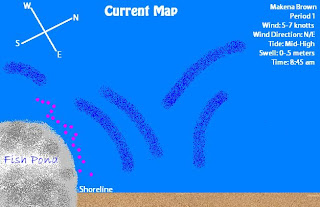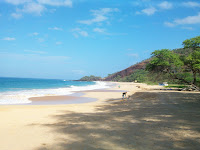There are two different origins of sand; biogenic and detrital. The chemical reaction between vinegar and sand determines the type of sand. If the sand bubbles when vinegar is added it is biogenic, if it does not bubble when vinegar is added then it is detrital. In this lab we will test different samples of sand with vinegar to determine the origin.
Question: Which beaches in south Maui will prove to be biogenic or detrital?
Hypothesis: I believe that Big Beach will contain biogenic sand since there is more reef surrounding the shoreline and I think that Black Sand Beach will be detrital because of all the cliffs and eroding materials around it. If the sand at big beach is biogenic than the sand will bubble when we add vinegar and if the sand at black sand beach really is detrital than it will not bubble when vinegar is added.
Materials: Pipette, pencil, sand, vinegar, container, notebook
Procedure:
1. Collect sand from chosen beaches and make observations of the beach surroundings in your journal
2. Gather remaining materials
3. Using the papette add vinegar to the sand
4. Observe any possible chemical reactions
5. Note chemical reactions and use the following formula to determine the origin of the sand
6. 2CH3COOH + CaCO3 ----> Ca(CH3COO)2 + H2O + CO2
Data:
Field Observations- On Monday Aprill 11th I was not able to make it to school but the class headed to collect sand samples at the following beaches and this is the data that was collected according to Meera Mennies:
"At Keawakapu I observed lava rocks on both ends of the beach and the sand was more a white/tan color.
At Kamaole 1 I observed rocks off of each end of the beach. Signs to protect coral reef suggests that there is a large amount of coral off shore. There was also sand dunes acting as protective barriers from the street.
At Sugar Beach I observed a lot of rocks and the sand was darker than the other sand samples. I also noticed that the water was very murky and I'm not sure what that means, but it might be an indication of animal and water activity which is related to the sand."
Observations:
Big Beach Sand: Light brown, tan, white, small shells, slightly fine.
After Vinegar: Noticeably bubbly, crackling sounds, which proves the sand at big beach to be biogenic.
Black Sand: Black, dark red, white, dark brown, consists of mostly rock sediment.
After Vinegar: Minumal bubble reaction which shows that the sand from black sand beach is slighty detrital.
Conclusion: After adding the vinegar to each of our sand samples I have concluded that my hypothesis was mostly correct. The sand taken from Big Beach is Biogenic because of the noticeably bubbly reaction the vinegar had caused. The sand from Black sand beach had very minimal bubble reactions, which means it is slightly detrital. We could have made a couple possible sources of error such as: testing the wrong sand samples, not adding enough drops of vinegar, or just getting a bad sample from the beach. I thought it was interesting to see what is in the sand of the beaches I usually go to all the time, even though I didnt participate much in this lab due to being sick and my broken wrist. I still enjoyed the learning about something cool, like the beach!
This was taken from our observations at Big Beach when we collected our sand samples! and on the right is a picture of the Black Sand Beach taken by my classmates while collecting data in the field.
 our starting point, we were trying to figure out whether the rise or run tool was at the top of the point. On the right is a picture of Allie and Lucas on top of the dune gathering data.
our starting point, we were trying to figure out whether the rise or run tool was at the top of the point. On the right is a picture of Allie and Lucas on top of the dune gathering data.







